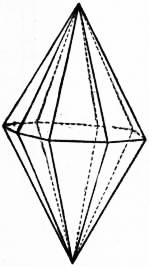Bipyramid
Bipyramid
A bipyramid is a type of polyhedron formed by joining two identical pyramids base-to-base. The resulting shape has a central axis of symmetry and is characterized by its polygonal base and two congruent sets of triangular faces.
Types of Bipyramids[edit | edit source]
Bipyramids can be classified based on the shape of their base:
- Triangular Bipyramid: Formed by joining two tetrahedra at their bases, resulting in a polyhedron with six triangular faces.
- Square Bipyramid: Created by joining two square pyramids at their bases, resulting in a polyhedron with eight triangular faces.
- Pentagonal Bipyramid: Formed by joining two pentagonal pyramids at their bases, resulting in a polyhedron with ten triangular faces.
Properties[edit | edit source]
Bipyramids have several notable properties:
- Faces: All faces of a bipyramid are triangular.
- Vertices: The number of vertices is equal to the number of vertices of the base polygon plus two.
- Edges: The number of edges is twice the number of edges of the base polygon.
- Symmetry: Bipyramids have a central axis of symmetry passing through the apexes of the two pyramids.
Applications[edit | edit source]
Bipyramids are used in various fields such as crystallography, where they describe the shapes of certain crystals. They are also found in geometry and architecture.
Related Polyhedra[edit | edit source]
Bipyramids are closely related to other polyhedra, including:
See Also[edit | edit source]
References[edit | edit source]
External Links[edit | edit source]
This article is a geometry-related stub. You can help WikiMD by expanding it!
Search WikiMD
Ad.Tired of being Overweight? Try W8MD's physician weight loss program.
Semaglutide (Ozempic / Wegovy and Tirzepatide (Mounjaro / Zepbound) available.
Advertise on WikiMD
|
WikiMD's Wellness Encyclopedia |
| Let Food Be Thy Medicine Medicine Thy Food - Hippocrates |
Translate this page: - East Asian
中文,
日本,
한국어,
South Asian
हिन्दी,
தமிழ்,
తెలుగు,
Urdu,
ಕನ್ನಡ,
Southeast Asian
Indonesian,
Vietnamese,
Thai,
မြန်မာဘာသာ,
বাংলা
European
español,
Deutsch,
français,
Greek,
português do Brasil,
polski,
română,
русский,
Nederlands,
norsk,
svenska,
suomi,
Italian
Middle Eastern & African
عربى,
Turkish,
Persian,
Hebrew,
Afrikaans,
isiZulu,
Kiswahili,
Other
Bulgarian,
Hungarian,
Czech,
Swedish,
മലയാളം,
मराठी,
ਪੰਜਾਬੀ,
ગુજરાતી,
Portuguese,
Ukrainian
Medical Disclaimer: WikiMD is not a substitute for professional medical advice. The information on WikiMD is provided as an information resource only, may be incorrect, outdated or misleading, and is not to be used or relied on for any diagnostic or treatment purposes. Please consult your health care provider before making any healthcare decisions or for guidance about a specific medical condition. WikiMD expressly disclaims responsibility, and shall have no liability, for any damages, loss, injury, or liability whatsoever suffered as a result of your reliance on the information contained in this site. By visiting this site you agree to the foregoing terms and conditions, which may from time to time be changed or supplemented by WikiMD. If you do not agree to the foregoing terms and conditions, you should not enter or use this site. See full disclaimer.
Credits:Most images are courtesy of Wikimedia commons, and templates Wikipedia, licensed under CC BY SA or similar.
Contributors: Prab R. Tumpati, MD





